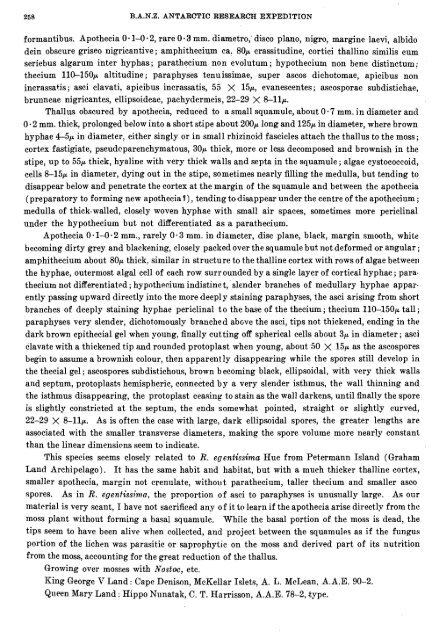You also want an ePaper? Increase the reach of your titles
YUMPU automatically turns print PDFs into web optimized ePapers that Google loves.
258 B.A.N.Z. ANTARCTIC RESEARCH EXPEDITION<br />
formantibus. Apothecia 0-1-0.2, rare 0.3 mm. diametro, disco plano, nigro, margine laevi, albido<br />
dein obscure griseo nigricantive; amphithecium ca. 8OP crassitudine, cortici thallino similis cum<br />
seriebus algarum inter hyphas; parathecium non evolutum; hypothecium non bene distinctum:<br />
thecium 110-150~ altitudine; paraphyses tenuissimae, super ascos dichotomae, apicibus non<br />
incrassatis; asci clavati, apicibus incrassatis, 55 X 15p, evanescentes; ascosporae subdistichae,<br />
brunneae nigricantes, ellipsoideae, pachydermeis, 22-29 X 8-llp.<br />
Thallus obscured by apothecia, reduced to a small squamule, about 0.7 mm. in diameter and<br />
0.2 mm. thick, prolonged below into a short stipe about 200p long and 125p in diameter, where brown<br />
hyphae 4-5~ in diameter, either singly or in small rhizinciad fascicles attach the thallus to the moss;<br />
cortex fastigiate, pseudoparenchymatous, 3OP thick, more or less decomposed and brownish in the<br />
stipe, up to 55p thick, hyaline with very thick walls and septa in the squamule ; algae cystococcoid,<br />
cells 8-15~ in diameter, dying out in the stipe, sometimes nearly filling the medulla, but tending to<br />
disappear below and penetrate the cortex at the margin of the squamule and between the apothecia<br />
(preparatory to forming new apothecia?), tending totdisappear under the centre of the apothecium ;<br />
medulla of thick-walled, closely woven hyphae with small air spaces, sometimes more periclinal<br />
under the hypothecium but not differentiated as a parathecium.<br />
Apothecia 0.1-0.2 mm., rarely 0.3 mm. in diameter, disc plane, black, margin smooth, white<br />
becoming dirty grey and blackening, closely paclred over the squamule but not deformed or angular ;<br />
amphithecium about 8OP thick, similar in structure to the thalline cortex with rows of algae between<br />
the hyphae, outermost a.1ga.l cell of each row surrounded by a single layer of cortical hyphae; para.<br />
thecium not differentiated ; hypothecium indistinct, slender branches of medullary hyphae apparently<br />
passing upward directly into the more deeply staining paraphyses, the asci arising from short<br />
branches of deeply staining hyphae periclinal to the base of the thecium ; thecium 110-l5Or~ tall ;<br />
paraphyses very slender, dichotomously branched above the asci, tips not thickened, ending in the<br />
darlr brown epithecial gel when young, finally cutting off spherical cells about 3p in diameter ; asci<br />
clavate with a thickened tip and rounded protoplast when young, about 50 X 1 5 as ~ the ascospores<br />
begin to assume a brownish colour, then apparently disappearing while the spores still develop in<br />
the thecial gel ; ascospores subdistichous, brown becoming black, ellipsoiclal, with very thick walls<br />
and septum, protoplasts hemispheric, connected by a very slender isthmus, the wall thinning and<br />
the isthmus disappearing, the protoplast ceasing to stain as the wall darkens, until finally the spore<br />
is slightly constricted at the septum, the ends somewhat pointed, straight or slightly curved,<br />
22-29 X 8-llp. As is often the case with large, dark ellipsoidal spores, the greater lengths are<br />
associated with the smaller transverse diameters, making the spore volume more nearly constant<br />
than the linear dimensions seem to indicate.<br />
This species seems closely related to R. egentissima Hue from Petermann Island (Graham<br />
Land Archipelago). It has the same habit and habitat, but with a much thicker thalline cortex,<br />
smaller apothecia, margin not crenulate, without parathecium, taller thecium and smaller asco<br />
spores. As in R. eyentissima, the proportion of asci to paraphyses is unusually large. As our<br />
material is very scant, 1 have not sacrificed any of it to learn if the apothecia arise directly from the<br />
moss plant without forming a basal squamule. While the basal portion of the moss is dead, the<br />
tips seem to have been alive when collected, and project between the quamules as if the fungus<br />
portion of the lichen was parasitic or saprophytrc on the moss and derived part of its nutrition<br />
from the moss, accounting for the great reduction of the thallus.<br />
Growing over mosses with Nostm, etc.<br />
King George V Land: Cape Denison, McKellar Islets, A. L. McLean, A.A.E. 90-2.<br />
Queen Mary Land : Hippo Nunatak, C. T. Harrisson, A.A.E. 78-2, type.

















